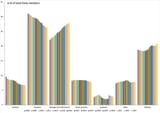Search Results
6/25/2025, 10:03:42 AM
>>508666083
>>508666948
>In the formative phase of the CPC, the Party was controlled by urban intellectual elites, but gradually its power base shifted and so did the composition. Workers and peasants led revolutionary struggles that formed the PRC in 1949, but in the wake of reform and opening up and subsequent developments, the Party opened its ranks to emerging working professionals, including capitalists, managers, lawyers, entrepreneurs, and other white-collar workers. Figure 4 depicts the longitudinal distribution of party members across different employment categories from 2008 to 2023. Workers have maintained a relatively stable representation, consistently below 10 per cent throughout the years. This is partly because the nature of the working class has changed and the Party allowed newer professional classes to join the Party, which emerged after the opening up of China’s economy. The relatively low levels of workers in recent times is also partly because the motive of the Party has shifted from revolution to governance. Similarly, peasants, who have historically constituted the largest segment of party membership, have seen a declining trend over time, dropping from above 30 per cent to around 25 per cent by 2023. On the other hand, the proportion of managers & professionals exhibits a notable upward trajectory, increasing from approximately 15 per cent in 2008 to nearly 25 per cent in 2023, indicating a significant enhancement in this demographics representation within the party mainly because of the number of professionals, managers and private sector employees (which the Party officially called ‘New Productive Forces’ since 2002) have increased in China.
>>508666948
>In the formative phase of the CPC, the Party was controlled by urban intellectual elites, but gradually its power base shifted and so did the composition. Workers and peasants led revolutionary struggles that formed the PRC in 1949, but in the wake of reform and opening up and subsequent developments, the Party opened its ranks to emerging working professionals, including capitalists, managers, lawyers, entrepreneurs, and other white-collar workers. Figure 4 depicts the longitudinal distribution of party members across different employment categories from 2008 to 2023. Workers have maintained a relatively stable representation, consistently below 10 per cent throughout the years. This is partly because the nature of the working class has changed and the Party allowed newer professional classes to join the Party, which emerged after the opening up of China’s economy. The relatively low levels of workers in recent times is also partly because the motive of the Party has shifted from revolution to governance. Similarly, peasants, who have historically constituted the largest segment of party membership, have seen a declining trend over time, dropping from above 30 per cent to around 25 per cent by 2023. On the other hand, the proportion of managers & professionals exhibits a notable upward trajectory, increasing from approximately 15 per cent in 2008 to nearly 25 per cent in 2023, indicating a significant enhancement in this demographics representation within the party mainly because of the number of professionals, managers and private sector employees (which the Party officially called ‘New Productive Forces’ since 2002) have increased in China.
Page 1
